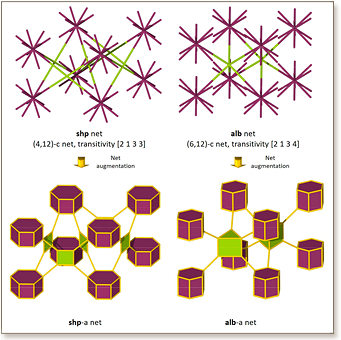

 Highly-connected and minimal edge-transitive nets (with one or two kinds of edge) can be regarded as ideal blueprints for the rational design and construction of metal-organic frameworks (MOFs). Here we report and affirm the prominence of highly-connected
nets as suitable targets in reticular chemistry for the design and synthesis of MOFs. Of special interest are augmented highly-connected binodal edge-transitive nets embedding a unique and precise positioning and connectivity of the net vertex figures,
regarded as net-coded building units (net-cBUs). Explicitly, a definite net-cBU encompasses precise geometrical information that codes uniquely and matchlessly a selected net, a compelling perquisite for the rational design of MOFs. Interestingly,
the double six-membered ring (d6R) building unit offers great prospective to be deployed as a net-cBU for the deliberate reticulation of the sole two edge-transitive nets with a vertex figure as a d6R, namely the (4,12)-coordinated shp net (square
and hexagonal prism) and the (6,12)-coordinated alb net (aluminium diboride, hexagonal prism and trigonal prism). Conceivably, we envisioned and proposed various MOF structures based on the derived shp and alb nets. Gaining access to the requisite
net-cBUs is essential for the successful practice of reticular chemistry; correspondingly organic and organic chemistries were deployed to afford concomitant molecular building blocks (MBBs) with the looked-for shape and connectivity. Practically,
the combination of the 12-connected (12-c) rare-earth (RE) polynuclear, points of extension matching the 12 vertices of the hexagonal prism (d6R) with a 4-connected tetracarboxylate ligand or a 6-connected hexacarboxylate ligand afforded the targeted
shp-MOF or alb-MOF, respectively. Intuitively, a dodecacarboxylate ligand can be conceived and purported as a compatible 12-c MBB, plausibly affording the positioning of the carbon centers of the twelve carboxylate groups on the vertices of the desired
hexagonal prism building unit, and combined with the complementary 4-c copper paddlewheel [Cu2(O2C−)4] cluster or 6-c metal trinuclear [M3O(O2C−)6] clusters/ zinc tetranulcear [Zn4O(O2C−)6] clusters to credibly afford the construction
of new MOF structures with underlying topologies based on derived shp and alb nets.
Highly-connected and minimal edge-transitive nets (with one or two kinds of edge) can be regarded as ideal blueprints for the rational design and construction of metal-organic frameworks (MOFs). Here we report and affirm the prominence of highly-connected
nets as suitable targets in reticular chemistry for the design and synthesis of MOFs. Of special interest are augmented highly-connected binodal edge-transitive nets embedding a unique and precise positioning and connectivity of the net vertex figures,
regarded as net-coded building units (net-cBUs). Explicitly, a definite net-cBU encompasses precise geometrical information that codes uniquely and matchlessly a selected net, a compelling perquisite for the rational design of MOFs. Interestingly,
the double six-membered ring (d6R) building unit offers great prospective to be deployed as a net-cBU for the deliberate reticulation of the sole two edge-transitive nets with a vertex figure as a d6R, namely the (4,12)-coordinated shp net (square
and hexagonal prism) and the (6,12)-coordinated alb net (aluminium diboride, hexagonal prism and trigonal prism). Conceivably, we envisioned and proposed various MOF structures based on the derived shp and alb nets. Gaining access to the requisite
net-cBUs is essential for the successful practice of reticular chemistry; correspondingly organic and organic chemistries were deployed to afford concomitant molecular building blocks (MBBs) with the looked-for shape and connectivity. Practically,
the combination of the 12-connected (12-c) rare-earth (RE) polynuclear, points of extension matching the 12 vertices of the hexagonal prism (d6R) with a 4-connected tetracarboxylate ligand or a 6-connected hexacarboxylate ligand afforded the targeted
shp-MOF or alb-MOF, respectively. Intuitively, a dodecacarboxylate ligand can be conceived and purported as a compatible 12-c MBB, plausibly affording the positioning of the carbon centers of the twelve carboxylate groups on the vertices of the desired
hexagonal prism building unit, and combined with the complementary 4-c copper paddlewheel [Cu2(O2C−)4] cluster or 6-c metal trinuclear [M3O(O2C−)6] clusters/ zinc tetranulcear [Zn4O(O2C−)6] clusters to credibly afford the construction
of new MOF structures with underlying topologies based on derived shp and alb nets.
DOI: 10.1039/C7FD00119C